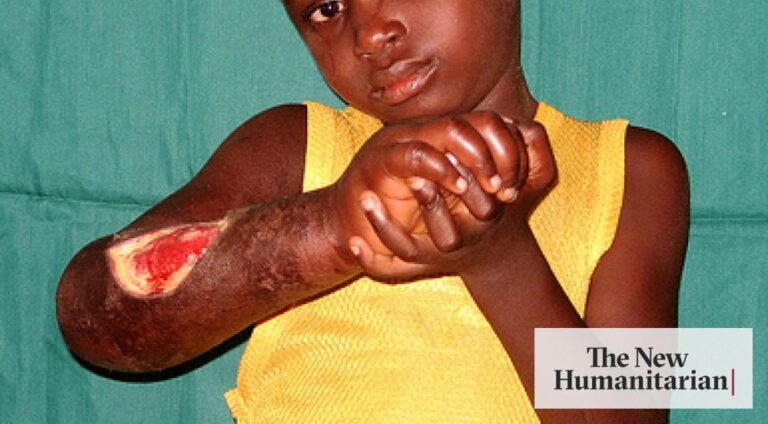By The North Journals Investigations Desk
In Malabu, a farming settlement tucked inside Adamawa State’s Fufore Local Government Area, anxiety runs deep. A mysterious illness has emerged, attacking its victims with terrifying precision. What begins as a painful boil soon ruptures into an open sore, consuming flesh and eroding the bones beneath.
“It started like a boil with pains, later got swollen and burst, then began to eat up the flesh on my leg, damaging the bones and causing serious pain,” recounted Mrs. Phibi Sabo, one of the patients. “This has left me with an open wound. I can’t explain what is happening to me.”
For Junaidu Adamu, another victim, the ordeal has already cost him more than ₦200,000 in medical expenses over two months, yet his condition continues to deteriorate.
By the time health officials confirmed the situation, the District Head of Malabu, Aliyu Hammawa, estimated that no fewer than 30 residents had been affected
On Saturday, Dr. Suleiman Bashir, Chairman of the Adamawa State Primary Healthcare Development Agency, officially confirmed the outbreak. Speaking with SaharaReporters, he disclosed that 28 people had been identified with the rare condition, with eight currently receiving care at the Modibbo Adama University Teaching Hospital (MAUTH), Yola.
Specimens from the patients have already been dispatched to the Nigeria Centre for Disease Control (NCDC) in Abuja for histology and analysis. “Results are expected in the next 10 days,” Dr. Bashir explained. “We encourage victims to accept medical treatment rather than rely on traditional medicine.”
However, out of the 28 patients identified, only eight consented to modern medical care, despite the state government offering to cover treatment costs. The majority continue to seek remedies in local facilities or through traditional healers.
The Adamawa outbreak is not an isolated incident. Nigeria’s public health history is marked by recurring, often baffling disease crises:
- 1996 – Kano Meningitis Epidemic: Over 100,000 infections led to thousands of deaths and sparked the infamous Pfizer Trovan trial, later mired in ethical controversies.
- 2010 – Zamfara Lead Poisoning: Initially mistaken for malaria, the crisis killed hundreds of children before being linked to artisanal gold mining.
- 2015 – Ondo Strange Skin Disease: Residents developed severe rashes and internal bleeding, traced to pesticide contamination.
- 2014 – Ebola Virus: Nigeria was globally commended for rapidly containing the outbreak using aggressive contact tracing and mass public awareness campaigns.
- 2017 – Monkeypox Resurgence: A virus unseen for decades reappeared, spreading across multiple states.
- Recurring – Lassa Fever & Cholera: Seasonal epidemics still claim hundreds of lives annually, underscoring fragile surveillance and sanitation systems.
The Adamawa crisis now fits into this troubling lineage—an unexplained epidemic testing Nigeria’s already strained healthcare preparedness.
Public health experts warn that mysterious outbreaks in rural areas often go underreported until they spiral into full-blown crises. According to World Bank health data, Nigeria spends just 3.6% of its GDP on healthcare, compared to the global average of 9.8%. Rural states like Adamawa remain particularly vulnerable due to limited diagnostic labs, poor referral systems, and high dependence on traditional medicine.
In Malabu, many residents admitted reluctance to visit hospitals due to cost, distance, and distrust of government health interventions. Instead, they rely on herbal mixtures or local bone-setters options that often worsen outcomes in bacterial or viral outbreaks.
Victims describe both physical and financial devastation. Open wounds have left patients unable to farm or work, threatening household incomes in a largely agrarian community. With treatments costing hundreds of thousands of naira and the state economy under pressure, families are quickly descending into debt.
More troubling is the possibility that the disease is contagious, though this remains unconfirmed pending laboratory results from NCDC. If transmissible, a wider epidemic could be imminent given the movement of people between villages and Yola, the state capital.
Adamawa State authorities say surveillance has been stepped up. Health workers are being mobilized to monitor local communities, while awareness campaigns encourage residents to report unusual symptoms early.
Dr. Bashir insists that swift laboratory confirmation and proper treatment are the best tools to curb the spread: “We cannot afford another case where misinformation, fear, and reliance on traditional medicine fuel a health disaster.”
For health policy watchers, the outbreak raises larger questions about Nigeria’s disease preparedness. Despite lessons from Ebola in 2014, the country continues to struggle with weak surveillance and slow rural response systems.
Data from the NCDC 2023 Situation Report shows that Lassa Fever alone killed 219 Nigerians last year, while cholera outbreaks affected nearly 25,000 people. Many experts argue that without consistent investment in rural healthcare infrastructure, every new outbreak risks becoming a national emergency.
As Adamawa awaits the NCDC’s laboratory results, the Malabu outbreak has already underscored a painful reality: Nigeria’s rural poor remain the most vulnerable when mystery diseases strike. Unless urgently addressed, the crisis could deepen, adding to the long list of health tragedies that have defined the country’s modern medical history.
For residents like Mrs. Sabo and Mr. Adamu, the uncertainty is agonizing. Their fight is not just against a strange disease consuming their bodies but against a system that has long struggled to protect them.
Image Credit: The Humaniterian
